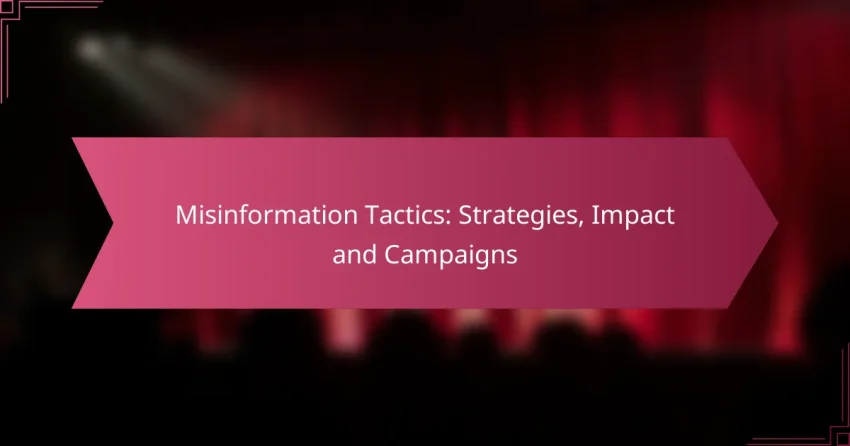Misinformation tactics are deliberate strategies designed to disseminate false or misleading information, often exploiting technology and social media to reach large audiences. These tactics can severely impact society by eroding trust in institutions, polarizing opinions, and influencing critical areas such as health and politics. Organized misinformation campaigns utilize various formats, including social media posts and fake news articles, to shape public perception and behavior around significant issues.
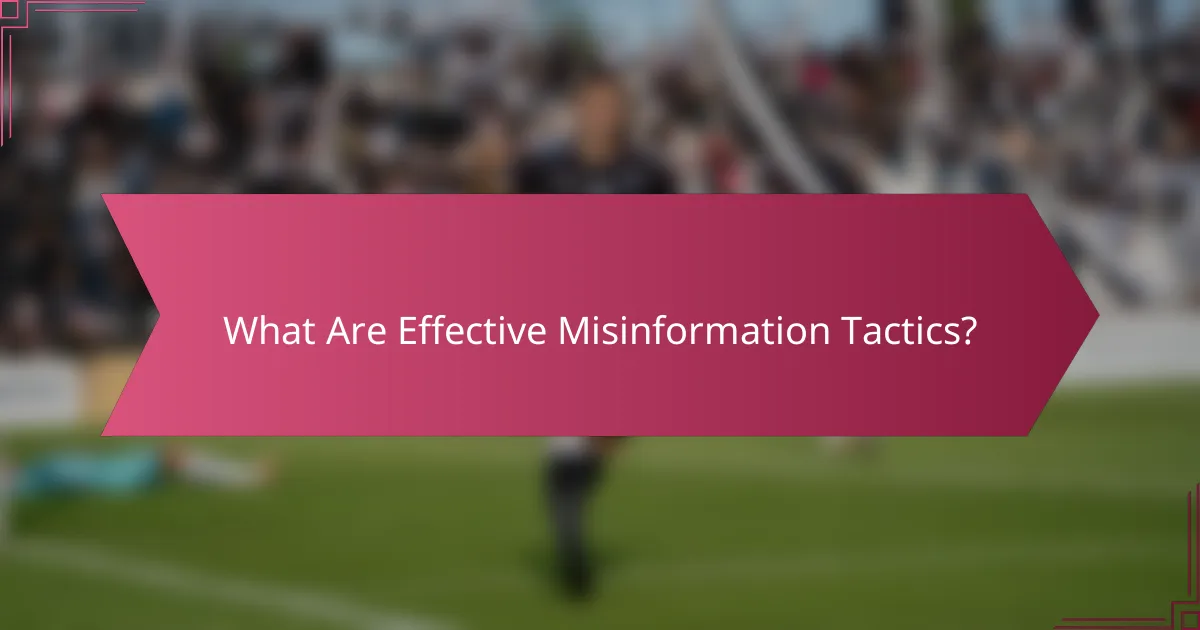
What Are Effective Misinformation Tactics?
Effective misinformation tactics are strategies used to spread false or misleading information intentionally. These tactics can manipulate public perception and influence behavior, often leveraging technology and social platforms to reach wide audiences.
Disinformation campaigns
Disinformation campaigns involve the organized dissemination of false information to mislead the public. These campaigns often target specific groups or issues, using tailored messages to provoke emotional responses or create division. For example, during elections, disinformation can skew voter opinions by spreading false narratives about candidates.
To recognize disinformation campaigns, look for coordinated messaging across multiple platforms and sources that lack credible backing. Engaging with verified news outlets can help counteract these tactics.
Social media manipulation
Social media manipulation refers to the strategic use of social networks to spread misinformation and shape public opinion. This can include creating fake accounts, using bots to amplify messages, or employing algorithms to promote misleading content. The rapid sharing capabilities of social media make it a powerful tool for misinformation.
To mitigate the effects of social media manipulation, users should verify information before sharing and be cautious of sensational headlines. Following reputable sources can also help identify credible information amidst the noise.
Deepfakes technology
Deepfakes technology uses artificial intelligence to create realistic but fabricated audio and video content. This can be particularly damaging as it can convincingly portray individuals saying or doing things they never did, potentially harming reputations or influencing opinions. For instance, a deepfake video of a political figure could mislead voters about their stance on critical issues.
To protect against deepfakes, individuals should critically assess video content, especially when it appears sensational or controversial. Tools and platforms that specialize in detecting deepfakes are becoming increasingly available and can aid in verification.
Astroturfing practices
Astroturfing practices involve creating a false impression of grassroots support for a cause or product. This is often done by hiring individuals to post favorable reviews or comments, making it seem like there is widespread public backing. For example, a company may pay for positive online reviews to boost its reputation artificially.
To identify astroturfing, look for patterns in reviews or comments that seem overly positive or lack personal detail. Engaging with a variety of sources can provide a more balanced view of public sentiment.
Selective reporting
Selective reporting occurs when media outlets highlight specific facts while ignoring others, leading to a skewed representation of events. This tactic can shape narratives by emphasizing certain viewpoints or omitting critical context. For example, a news story may focus solely on the negative aspects of a policy without discussing its potential benefits.
To combat selective reporting, consumers should seek multiple perspectives on a story and consult diverse news sources. Understanding the full context can help form a more informed opinion on complex issues.
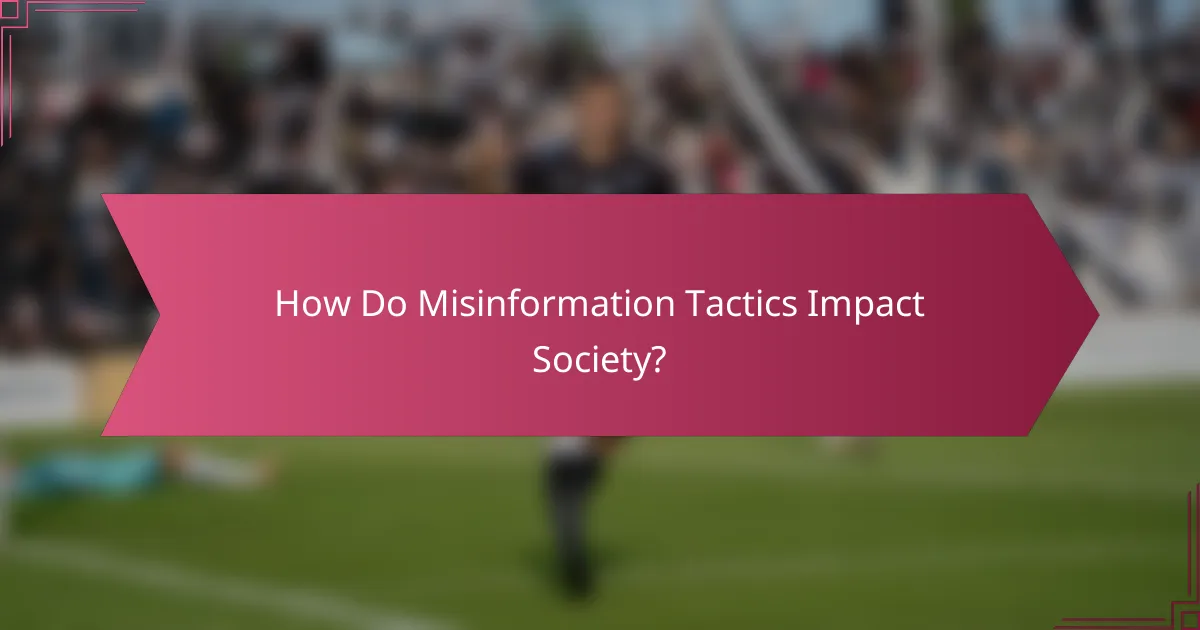
How Do Misinformation Tactics Impact Society?
Misinformation tactics significantly impact society by undermining trust in institutions, polarizing public opinion, influencing electoral outcomes, and spreading health-related falsehoods. These tactics can distort perceptions and create divisions, leading to real-world consequences.
Public trust erosion
The spread of misinformation erodes public trust in media, government, and scientific institutions. When individuals encounter conflicting information, they may become skeptical of credible sources, leading to a decline in societal cohesion.
For example, repeated exposure to false narratives can cause citizens to question the integrity of news outlets and public officials, fostering an environment where conspiracy theories thrive. This distrust can hinder effective communication during crises, such as natural disasters or public health emergencies.
Polarization of opinions
Misinformation tactics contribute to the polarization of opinions by creating echo chambers where individuals only engage with like-minded perspectives. This phenomenon can intensify social divisions and reduce the likelihood of constructive dialogue.
Social media algorithms often amplify divisive content, leading to a fragmented public discourse. As a result, people may become more entrenched in their views, making it challenging to reach consensus on critical issues affecting society.
Influence on elections
Misinformation can significantly influence elections by shaping voter perceptions and behaviors. False information about candidates or policies can sway public opinion and alter the electoral landscape.
For instance, misleading claims about voter fraud or election integrity can discourage participation or incite unrest. In recent elections, misinformation campaigns have targeted specific demographics, manipulating their voting decisions and undermining democratic processes.
Health misinformation effects
Health misinformation can have dire consequences, particularly during public health crises. False claims about treatments, vaccines, or disease transmission can lead to harmful behaviors and decreased vaccination rates.
For example, during the COVID-19 pandemic, misinformation about vaccine safety contributed to hesitancy, impacting herd immunity efforts. It is crucial for individuals to verify health information through reliable sources to protect their well-being and that of their communities.

What Are Common Misinformation Campaigns?
Common misinformation campaigns are organized efforts to spread false or misleading information, often aimed at influencing public opinion or behavior. These campaigns can take various forms, including social media posts, fake news articles, and manipulated images, and they typically target significant issues like health, politics, and environmental concerns.
COVID-19 misinformation
COVID-19 misinformation includes false claims about the virus’s origins, prevention methods, and vaccine efficacy. For example, some campaigns promoted unverified treatments or downplayed the importance of vaccination, leading to confusion and hesitancy among the public.
To combat COVID-19 misinformation, individuals should rely on trusted sources such as the World Health Organization (WHO) or local health authorities. Always verify claims before sharing information, especially regarding health-related topics.
Election interference examples
Election interference through misinformation often involves spreading false narratives about candidates or voting processes. Tactics may include the dissemination of fake news articles, manipulated videos, or misleading social media posts aimed at discrediting opponents or suppressing voter turnout.
For instance, during recent elections in various countries, misinformation campaigns targeted specific demographics to sway their voting behavior. It is crucial for voters to fact-check information and consult official election resources to ensure they are making informed decisions.
Climate change denial campaigns
Climate change denial campaigns aim to undermine scientific consensus on climate change by promoting misleading information about its causes and effects. These campaigns often use tactics such as cherry-picking data or funding research that downplays the urgency of climate action.
To navigate climate change misinformation, individuals should seek information from reputable scientific organizations and peer-reviewed studies. Engaging with credible sources helps to counteract misleading narratives and supports informed discussions about climate policy and action.
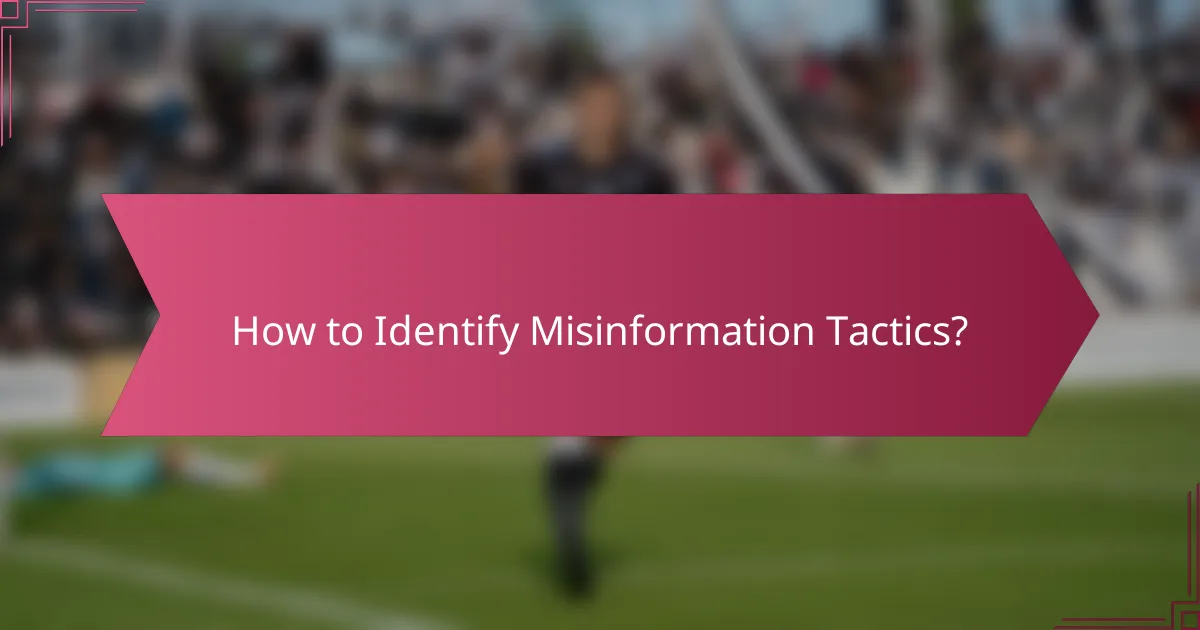
How to Identify Misinformation Tactics?
Identifying misinformation tactics involves recognizing common strategies used to spread false information. Key indicators include sensational language, lack of credible sources, and emotional appeals that aim to provoke a reaction rather than inform.
Fact-checking resources
Utilizing fact-checking resources is essential for verifying claims. Websites like Snopes, FactCheck.org, and PolitiFact provide thorough investigations into popular rumors and misinformation. These platforms often include citations and sources, helping users discern fact from fiction.
When using these resources, check the publication date and context of the information. Misinformation can evolve, so ensure the fact-check is recent and relevant to the current discussion.
Media literacy programs
Media literacy programs educate individuals on how to critically evaluate information sources. These programs often include workshops and online courses that teach skills such as identifying bias, understanding media ownership, and recognizing persuasive techniques.
Participating in local community initiatives or online courses can enhance your ability to spot misinformation. Look for programs endorsed by educational institutions or reputable organizations to ensure quality content.
Critical thinking skills
Developing critical thinking skills is vital for assessing the credibility of information. This involves questioning the source, examining the evidence presented, and considering alternative viewpoints. A healthy skepticism can help you avoid falling for misleading narratives.
To practice critical thinking, engage in discussions that challenge your viewpoints and analyze articles from various perspectives. Techniques such as the “5 Ws” (who, what, where, when, why) can guide your evaluation process.
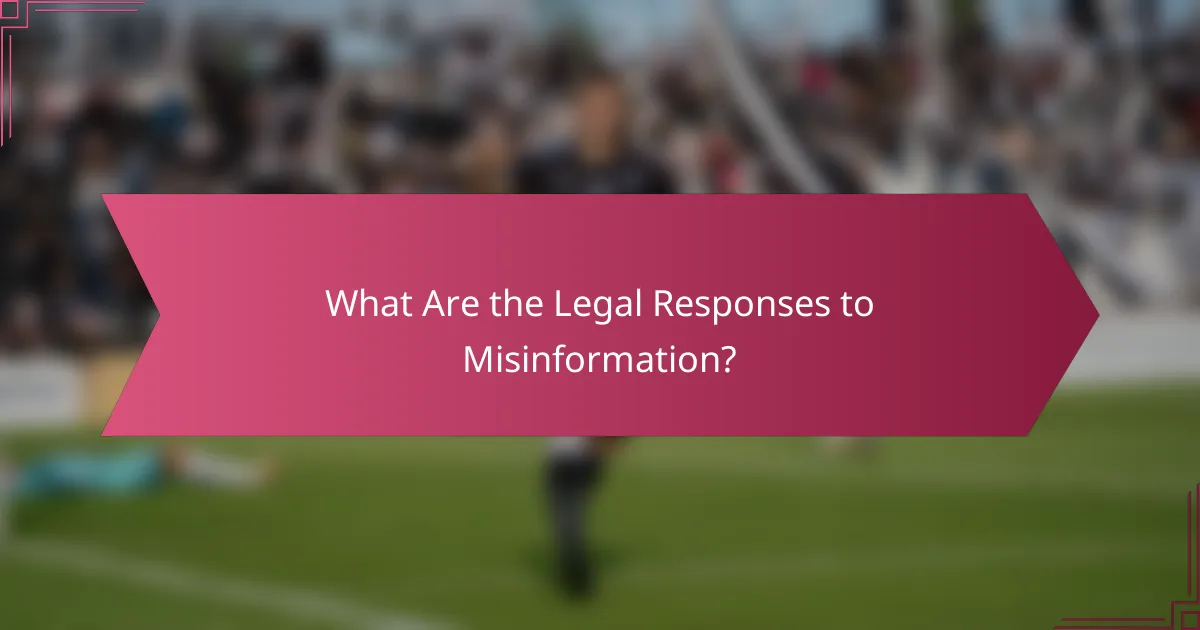
What Are the Legal Responses to Misinformation?
Legal responses to misinformation encompass various strategies aimed at regulating false information dissemination and holding perpetrators accountable. These responses can include legislation, regulatory frameworks, and legal actions taken against individuals or organizations that spread misinformation.
Regulatory frameworks
Regulatory frameworks are essential for establishing guidelines and standards to combat misinformation. Many countries have implemented laws that require social media platforms to take responsibility for the content shared on their sites, ensuring they actively monitor and remove false information. For example, the European Union’s Digital Services Act mandates that platforms must take measures to prevent the spread of harmful misinformation.
In addition to social media regulations, some jurisdictions have laws that specifically target misinformation in public health, such as during pandemics. These laws often allow for swift action against those spreading false claims that could jeopardize public safety.
Case studies of legal actions
Case studies illustrate how legal actions can effectively address misinformation. In the United States, several lawsuits have been filed against companies and individuals for spreading false information regarding COVID-19 vaccines, resulting in significant penalties and public retractions. These cases highlight the potential for legal repercussions to deter the spread of harmful misinformation.
Another notable example is the legal action taken by various governments against social media platforms for failing to comply with misinformation regulations. These cases often lead to settlements that require platforms to enhance their content moderation practices, thereby reducing the prevalence of false information online.
